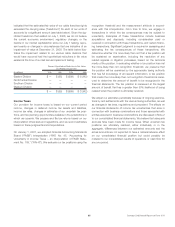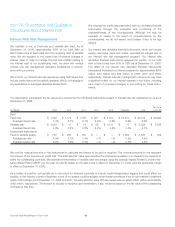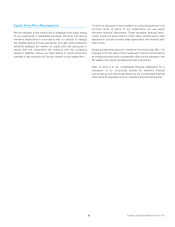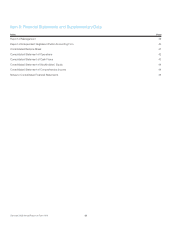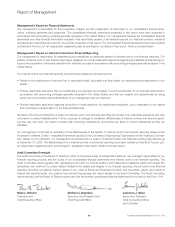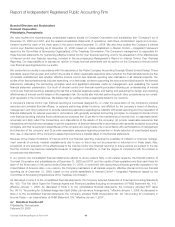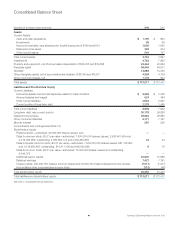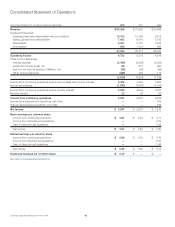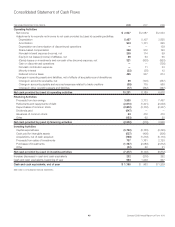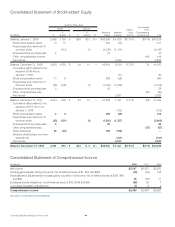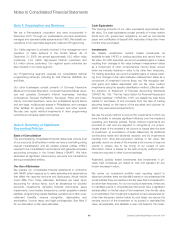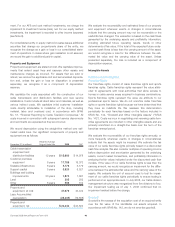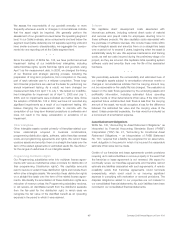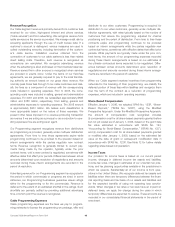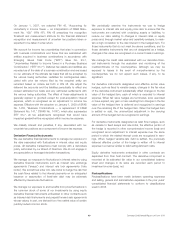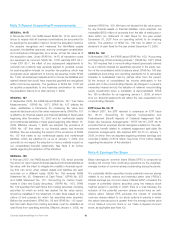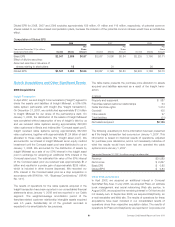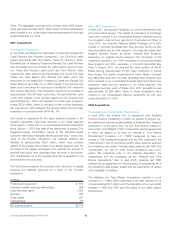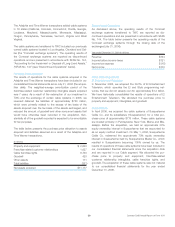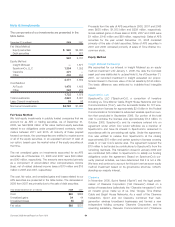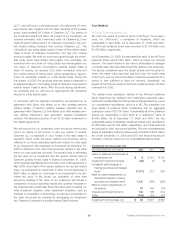Comcast 2008 Annual Report Download - page 47
Download and view the complete annual report
Please find page 47 of the 2008 Comcast annual report below. You can navigate through the pages in the report by either clicking on the pages listed below, or by using the keyword search tool below to find specific information within the annual report.
Notes to Consolidated Financial Statements
Note 1: Organization and Business
We are a Pennsylvania corporation and were incorporated in
December 2001. Through our predecessors, we have developed,
managed and operated cable systems since 1963. We classify our
operations in two reportable segments: Cable and Programming.
Our Cable segment is primarily involved in the management and
operation of cable systems in the United States. As of
December 31, 2008, we served approximately 24.2 million video
customers, 14.9 million high-speed Internet customers and
6.5 million phone customers. Our regional sports networks are
also included in our Cable segment.
Our Programming segment operates our consolidated national
programming networks, including E!, Golf Channel, VERSUS, G4
and Style.
Our other businesses consist primarily of Comcast Interactive
Media and Comcast Spectacor. Comcast Interactive Media devel-
ops and operates Comcast’s Internet businesses, including
Comcast.net, Fancast, thePlatform, Fandango, Plaxo and Daily-
Candy. Comcast Spectacor owns two professional sports teams
and two large, multipurpose arenas in Philadelphia, and manages
other facilities for sporting events, concerts and other events.
We also own equity method investments in other programming
networks and wireless-related companies.
Note 2: Summary of Significant
Accounting Policies
Basis of Consolidation
The accompanying consolidated financial statements include (i) all
of our accounts, (ii) all entities in which we have a controlling voting
interest (“subsidiaries”) and (iii) variable interest entities (“VIEs”)
required to be consolidated in accordance with generally accepted
accounting principles in the United States (“GAAP”). We have
eliminated all significant intercompany accounts and transactions
among consolidated entities.
Our Use of Estimates
We prepare our consolidated financial statements in conformity
with GAAP, which requires us to make estimates and assumptions
that affect the reported amounts and disclosures. Actual results
could differ from those estimates. Estimates are used when
accounting for various items, such as allowances for doubtful
accounts, investments, derivative financial instruments, asset
impairments, nonmonetary transactions, certain acquisition-related
liabilities, programming-related liabilities, pensions and other post-
retirement benefits, revenue recognition, depreciation and
amortization, income taxes, and legal contingencies. See Note 8
for our discussion on fair value estimates.
Cash Equivalents
The carrying amounts of our cash equivalents approximate their
fair value. Our cash equivalents consist primarily of money market
funds and U.S. government obligations, as well as commercial
paper and certificates of deposit with maturities of less than three
months when purchased.
Investments
We classify unrestricted, publicly traded investments as
available-for-sale (“AFS”) or trading securities and record them at
fair value. For AFS securities, we record unrealized gains or losses
resulting from changes in fair value between measurement dates
as a component of other comprehensive income (loss), except
when we consider declines in value to be other than temporary.
For trading securities, we record unrealized gains or losses result-
ing from changes in fair value between measurement dates as a
component of investment income (loss), net. We recognize real-
ized gains and losses associated with our fair value method
investments using the specific identification method. Effective with
the adoption of Statement of Financial Accounting Standards
(“SFAS”) No. 159, “The Fair Value Option for Financial Assets and
Financial Liabilities,” (“SFAS No. 159”), we classify the cash flows
related to purchases of and proceeds from the sale of trading
securities based on the nature of the securities and purpose for
which they were acquired (see Note 3).
We use the equity method to account for investments in which we
have the ability to exercise significant influence over the investee’s
operating and financial policies. Equity method investments are
recorded at cost and are adjusted to recognize (i) our propor-
tionate share of the investee’s net income or losses after the date
of investment, (ii) amortization of basis differences, (iii) additional
contributions made and dividends received, and (iv) impairments
resulting from other-than-temporary declines in fair value. We
generally record our share of the investee’s net income or loss one
quarter in arrears due to the timing of our receipt of such
information. Gains or losses on the sale of equity method invest-
ments are recorded in other income (expense).
Restricted, publicly traded investments and investments in pri-
vately held companies are stated at cost and adjusted for any
known decrease in value.
We review our investment portfolio each reporting period to
determine whether there are identified events or circumstances that
would indicate there is a decline in the fair value that is considered to
be other than temporary. For our non-public investments, if there are
no identified events or circumstances that would have a significant
adverse effect on the fair value of the investment, then the fair value
is not estimated. If an investment is deemed to have experienced an
other-than-temporary decline below its cost basis, we reduce the
carrying amount of the investment to its quoted or estimated fair
value, as applicable, and establish a new cost basis for the invest-
45 Comcast 2008 Annual Report on Form 10-K


